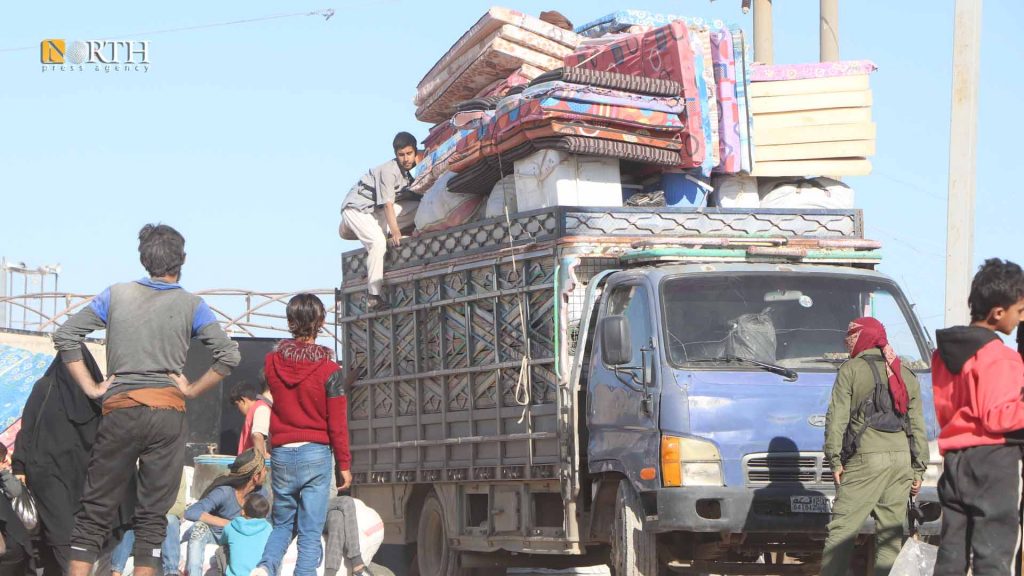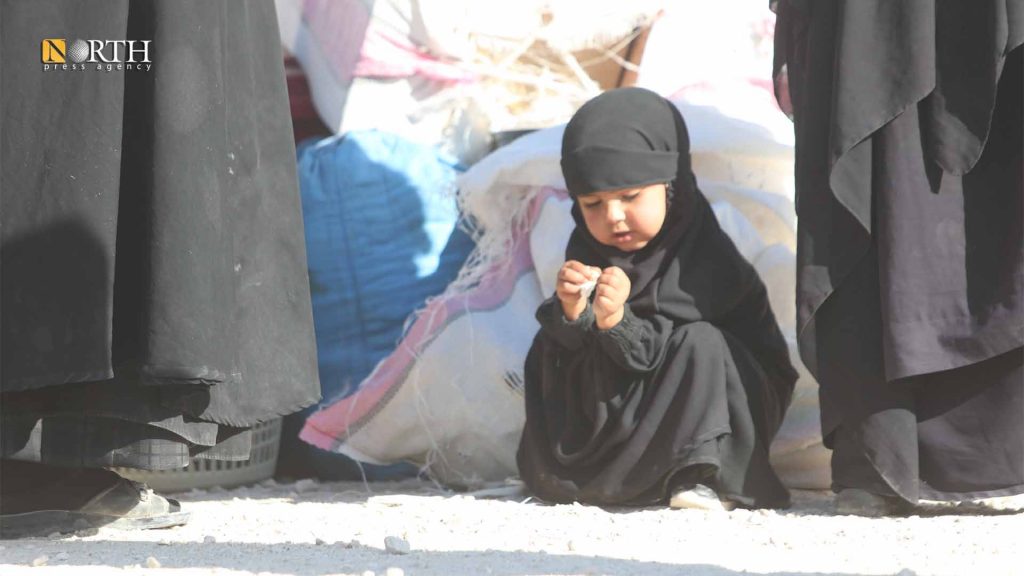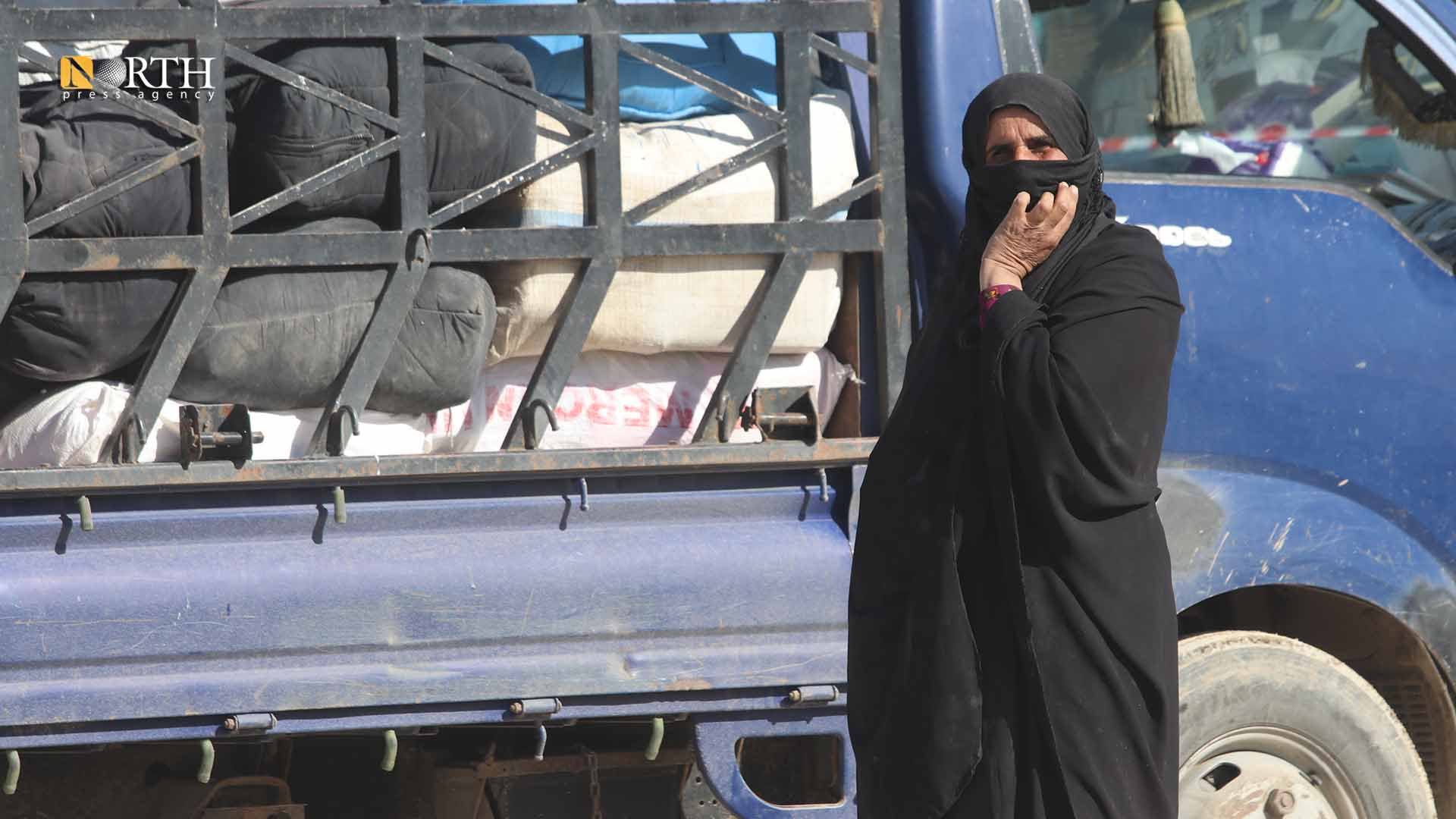HAWL CAMP, Syria (North Press) – Despite their delight when leaving Hawl Camp, which is the most dangerous in the world, Syrian families fear their unknown fate that is awaiting them in areas run by Iranian-backed factions and Syrian government forces, southeast of Deir ez-Zor, leaving them to face the hardest options.
The 74-year-old woman, Onoud al-Hamad left the Hawl Camp within the batch that included 48 families last week.
While waiting for a bus to transfer her, the old woman, who hails from al-Quriyah town, 55 km southeast of Deir ez-Zor, said, her family cannot head to the town after the government seized their house, lands, and property, while Iranian-backed factions seized other houses.
The Hawl Camp, 40 km east of Hasakah, is a house of about 57,566 individuals of 15,650 families, including 2,448 families of the detainees and dead of the ISIS foreign militants.
In October 2020, the Executive Council in the Autonomous Administration of North and East Syria (AANES) decided to evacuate Syrian families who wish to leave the camp following an initiative by the Syrian Democratic Council (SDC) and tribal heads.

Money in turn for houses
Three years ago, al-Hamad’s family, which includes seven members, fled the shelling by warplanes of the Syrian government and Russia towards the Hawl Camp.
“They do not accept to return our possessions to us,” the woman said while preparing herself to leave the camp.
The family is going to head to al-Tayyana town, east of the Euphrates, where they hope that they can find some good people that can offer them a place to reside in until they can manage their issues.
“The regime forces demand money in turn for allowing us to return to our house, but where will we get them money? Some relatives of us there in the town told us that they [government forces and Iranian-backed factions] had rentd our houses and lands,” al-Hamad said.
Al-Quriyah, which is the biggest town in the eastern countryside of Deir ez-Zor, is affiliated with al-Mayadin district, 55 km east of Deir ez-Zor, and it is an agricultural area with about 40,000 people residing in.
The town was massively destroyed during the battles against ISIS.
Iranian-backed factions seized civilians’ houses and converted them into headquarters, as they confiscated dozens of houses under the pretext that their owners have joined either Turkish-backed factions, ISIS, or that they are present in areas held by the AANES.
Most residents of al-Quriyah town are of al-Qar’an clan that is affiliated with al-Akidat tribe.
Salvage of risks
As a result of the airstrikes and battles that took place west of the Euphrates River between the Syrian government and Russia on one hand, and ISIS on the other hand in 2017, the house of the 43-year-old Umm Youssef, who hails from al-Quriyah town, was destroyed forcing her to flee the town with her family and ended up in the Hawl Camp.
A third of the indigenous population of al-Quriyah town are residing in rented houses or tents in areas run by the Syrian Democratic Forces (SDF).
They cannot return to their town for fear of the government military compulsory service or security reports and tips that are filled to pressure residents and force them to leave their houses and possessions in the event that they return to the town, according to Mahmoud Abdulghafour, a pseudonym for an IDP of al-Quriyah and resides in al-Tayyana.
Umm Youssef believes that an unknown fate is awaiting her family of nine, after leaving the camp, especially with her husband who suffers from a permanent injury, “Had it not been for the deterioration of the security and living conditions in the camp for a year, we would not have wanted to leave now,” she said.
Hawl Camp is known as a “ticking time bomb” due to the presence of extremists of ISIS’ wives and children, and tens of thousands of their supporters in a camp sometimes described as “the most dangerous camp in the world.”
So far, the number of Syrian families that left the camp has come up to 1,226 including 4,549 individuals.
Some Syrian families, which left the camp, deny being tied with ISIS, but they confirm that they fled their houses and areas during the operations that were carried out against its militants by SDF supported by the US-led Global Coalition and the government forces supported by Russia.
Meanwhile, others claim to have worked with ISIS in non-combat services.
Hawl Camp is an international dilemma that all international powers should assume responsibility for solving this issue, Internal Security Forces of North and East Syria (Asayish) said on November 13.
This came in a statement by the General Command of Asayish following a killing incident of two residents of the camp one of which was head of the Iraqi Council for Refugees by an ISIS sleeper cell, on November 12.
Despite being gratitude for fleeing all those risks, Umm Youssef say, bigger responsibilities were placed upon on her, “since my husband cannot work, I will be forced to secure my family’s needs in light of the price hike.”

Iranian influence
Currently, al-Quriyah town is being run by several Iranian-backed factions such as Liwa Fatemiyoun, Liwa Zainebiyoun, Kata’ib al-Imam Ali, and Islamic Revolutionary Guard Corps (IRGC) in addition to limited numbers of the government forces represented by the Fourth Armored Division on the entrance of the public market in the town and Air Force Intelligence Center on the right bank of the Euphrates River.
Meanwhile, residents living in the government-held areas in Deir ez-Zor say, they have become eyewitnesses on verbal reports against families living there in order to flee their houses.
Iranian-backed factions pay money to brokers for sake of buying real states and lands in towns whose residents left their houses and are residing in other areas.
Those factions are seizing over 230 houses in al-Quriyah town with their leaders residing in most of them while other houses were turned into recruiting centers, which deploy in several neighborhoods, supervised by Iraqis, Pakistanis and Afghans who came with the Iranian forces.
Iran seeks to eradicate the religious culture of the region, as it has opened several Shiite shrines, such as the shrine of Imam Ali and several cultural centers where Iranian-backed factions hold symposiums on the Shiite sect, along with other methods of carrot and stick method urging residents to convert to the Shiism.
As for the 56-year-old Hamdan al-Ahmad, a resident of al-Quriyah, who fled his town during the war against ISIS, is residing in a small tent in the town of al-Shannan, in the SDF-held eastern countryside of Deir ez-Zor, after he has left the Hawl Camp with his family of nine, recently.
Al-Ahmad noted that his relatives sold his possessions and lands through brokers to IRGC and after he appealed to some notables of the town in order to intervene to return his possessions, the IRGC demanded documents proving his ownership.
But all title deeds were burnt while he was fleeing his house under heavy shelling, according to him.

